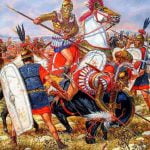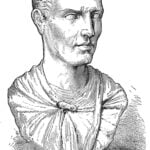Chapters
At first, the Acropolis in Athens is associated mainly with monuments from the times of ancient Greece. But in the Roman period, in the years 114-116 CE, a tombstone monument to Gaius Julius Antiochus Epiphanes Philopappus was built. The monument with an interesting background, because the inscriptions on it are written in both Greek and Latin. Both have different messages.
Gaius Filopappus
First things first. Who was our Gaius Philopappus, whose impressive tombstone has survived to this day? He was born around 65 in Samosata, the capital of the Kingdom of Commagene, at the court of his grandfather Antiochus IV with whom he was very close. The nickname Filopappus means “the one who loves his grandfather”. Philopappus’ sister was Julia Balbilla, later a close friend of Hadrian and Empress Sabina. In 72 CE, Antiochus IV was accused of treason by the Syrian governor, thus Emperor Vespasian ordered him to relinquish the throne. Although Antiochus lost his throne and was taken with his whole family to Rome, he managed to convince the emperor of his loyalty. In Rome, they lived a prosperous life and were among the highest elite.
Filopappos, belonging to the elite of Roman society, became a friend of Emperor Trajan and Hadrian. He was active politically and religiously. After the death of his grandfather, Philopappos and his family moved to Athens, where over time he became an outstanding and respected citizen and donor of the city. He had both Roman and Athenian citizenship. Twice he was a sick person (a person appointed by the archon, who was to select a choir to perform in theatrical or musical performances and finance its preparation and furnish it with costumes). He was also elected archon of Athens (the highest polis official who presided over the Areopagus council and dealt with the most important matters of the Athenian polis).
In the years CE 105-116 he became a member of the Brotherhood of the Arval (a college of 12 priests of the goddess of light and Mars who, with closed doors, prayed for a good harvest and performed a dance that originated from fertility cults). Emperor Trajan joined him in the Praetorian Guard, promoted senator and consul in 109 (he was one of the first people of eastern origin to become consul in Rome).
Monument
Gaius Filopappus died in 116. His sister Julia Balbilla and the people of Athens decided to fund a monument for him. The hill of Muzejon (later called “Hill of Filopappos”), located southwest of the Acropolis, was chosen.
It is a two-story white marble structure measuring 9.11 by 9.65 meters. It should be noted that the given dimensions refer to the remains that we can now see because only a part of the facade has survived. In the pedestal, there was probably a burial chamber measuring 3 by 3.40 m. The entrance to it was in the center, in the rear wall of the structure (it probably served as the second elevation with pilasters and a decorative pediment). There is a decorative façade on the north side. It consists of three parts: the first part shows a frieze and is 3.51 m high, the second one, 6.5 m high, contains niches with statues, while the third one consists of a pediment, the height of which, unfortunately, we do not know.
On the facade of the monument, two heavily damaged statues have been preserved, which are located in niches. Originally there were 3 niches with statues. In the central niche, there is a statue of Philopappos himself – he is a sitting figure with a bare chest, legs are covered with himation. This style of clothing is little Roman. However, it resembles Greek statues of gods or heroes. It is also possible that it was modeled on the statues of Zeus or Jupiter. It cannot be denied that the statue’s divine character is magnified by placing the statue inside a vaulted niche – which alludes to a cult place in the temple.
In the second niche, next to Philopappos, there is a monument showing his grandfather – King Antiochus IV. It is a bit smaller than the central statue. Interestingly, he does not have traditional royal robes or armor but is dressed in a toga that covers his entire body. He was shown as a Roman judge.
It is assumed that the monument, which has not survived, represented King Seleucus Nicator – the founder of the Seleucid dynasty. The composition would then create a story showing the power and continuity of the dynastic.
The frieze shows a rich sculptural decoration, although unfortunately it is preserved in fragments. But despite the lack of many parts, individual characters can be separated and identified. In the middle part, we can see a man on a chariot drawn by four horses. The man is probably Philopappos, who is wearing a tunic and a toga. He is holding a scepter in his left hand and making a gesture with his right hand. Six men in togas walk in front of the chariot, probably lictors. Behind the chariot, we can also observe a male figure. Unfortunately, none of the characters has their head or face preserved.
The frieze performance in a way mimics the scene from the Arch of Titus, where we see Titus’ triumphal march. Filopappos takes an almost identical pose as Titus, even the horses are shown in the same way. Josephus Flavius mentions that Philopappos’ grandfather – Antiochus IV fought with Titus in the Jewish War and he took part in the siege of Jerusalem. It is possible, therefore, that he told his grandson the stories he experienced with the emperor, and the emperor decided to recall them at least in memory by imitating a well-known monument in Rome. By referring to the story depicted on the Arch of Titus, he declares that he belongs to the royal family who fought alongside the emperor.
In summary, the frieze is very Roman in its style and resembles a victory procession. Filopappos himself is a political and civic figure who deals with the day-to-day affairs of the state and policies. The statue, on the other hand, seems to be in the Greek-Hellenistic style. He is dressed as a god or emperor. He is a descendant of kings and this is his inheritance.
The first inscription we can find is on the column between the two statues. It is in Latin and lists the full name and origin of Philopappos, his titles, achievements and the name of Emperor Trajan, who granted him the rank of praetorian. Giving the titles he held during his lifetime, he is shown as a very important member of society.
The second inscription is in Greek and is under the statue on the left. He signs the statue of Antiochus Epiphanes and mentions its title. Thus, he preserves the dynastic context of the monument and himself.
The third inscription is under the statue of Philopappos and is also in Greek. It contains the Athenian first name and the name of the father and his estate. This way of spelling the name makes him look like an Athenian citizen and points to his connection to the Athenian polis.
Every aspect of the monument, from the imposing size, the divine nature of his dowry, to the dynastic inscriptions of his grandfather, seems to elevate Philopappos’ status and underline his pride in his ancestors. Greek and Latin inscriptions express a dual cultural identity and are targeted at multiple audiences.
Times after antiquity
Cyriacus of Ancona (1391-1452), the first traveler who sketched the monument, writes that under the unpreserved monument in the third niche, there was the inscription Seleucus Nicator and the king’s dynastic name referring to Philopappos (no trace of the inscription has remained to our times).
In 1687, during the siege of Athens by the Venetians, a Turkish missile hit the monument. It was he who probably damaged the monument the most, and led more or less to the state we see it in today.
In 1898, excavations were carried out at the monument. A year later, the first restoration works began. In the 1940s, another small excavation around the tomb was carried out. In contrast, recent research has confirmed that many of the monument’s architectural elements were used in the construction of the minaret in the Parthenon.
- Sculptures on the monument of Philopappos
- Decorations on the monument of Philopappos










